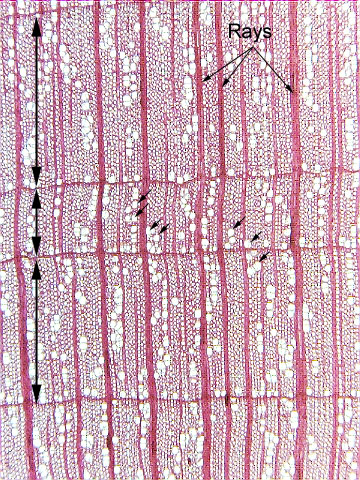 Fig.
15.1-1. Transverse section of wood of Ilex
opaca (American holly, a dicot or hardwood) Each of the double-headed arrows
on the left indicate an annual
ring. The lower head of each arrow is near the earlywood, the upper
head is near latewood (by common agreement, transverse sections of wood are
shown with the younger rings near the top, as if the vascular cambium were
somewhere above the top of the micrograph). The vertical red stripes are rays,
and altogether they make up the ray
system of wood. Between the rays are masses of fibers and vessels;
these masses make up the axial system of wood. Even at this low
magnification, it is possible to see significant detail in the vessels: they are
present (so this cannot be a conifer), they are uniformly distributed within
each annual ring (so this wood is diffuse porous), and all vessels are
approximately the same size without any being extremely wide or narrow.
Fig.
15.1-1. Transverse section of wood of Ilex
opaca (American holly, a dicot or hardwood) Each of the double-headed arrows
on the left indicate an annual
ring. The lower head of each arrow is near the earlywood, the upper
head is near latewood (by common agreement, transverse sections of wood are
shown with the younger rings near the top, as if the vascular cambium were
somewhere above the top of the micrograph). The vertical red stripes are rays,
and altogether they make up the ray
system of wood. Between the rays are masses of fibers and vessels;
these masses make up the axial system of wood. Even at this low
magnification, it is possible to see significant detail in the vessels: they are
present (so this cannot be a conifer), they are uniformly distributed within
each annual ring (so this wood is diffuse porous), and all vessels are
approximately the same size without any being extremely wide or narrow.